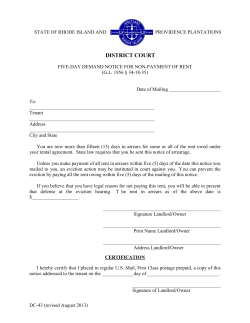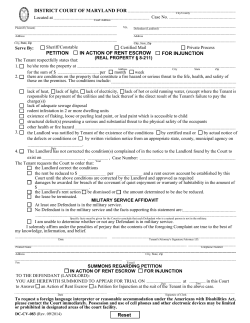
File
SENATUS POPULUSQUE ROMANUS The senate and the people of Rome Lecture VIII Land Land ‘Land’ = land together with the buildings built on it. Land a rule of Roman law says that ownership of land carries with it whatever was built on the land. Land For Romans land was always the primary investment. Land Various ways in which land may be managed: it may be occupied by the owner, by a tenant, or in some other way, such as under a usufruct. Land Rural and urban letting. Leases The owner might let out his property for occupation by tenants. A lease in Roman law is a contract. Leases A lease in Roman law is a contract. It therefore generated rights in personam: that is, personal rights of the landlord against the tenant and vice versa. Leases The principal obligation on the part of the landlord was to give the tenant vacant possession of the premises leased, and on the part of the tenant to pay the rent. Leases Leases were regularly for periods of several years; The rent was typically paid in lump sums at yearly or half-yearly intervals. Leases Tenants might sue their landlords. Leases or rural property Importance of continuity in tenancies because of: ① a shortage of tenants ② a lack of other possible investments ③ a limit to the area the landlord could himself cultivate Leases or rural property Importance of continuity in tenancies: Evidence of instances where ① the question is raised of compelling a tenant to remain in occupation ② a case where the seller deceives the buyer into thinking that the property sold is occupied by a tenant. The landlord and the tenant ① Landlords might lease premises directly to the tenants who were to occupy them. The landlord and the tenant ② in the case of leases of flats: leases of the premises as a whole to a tenant who would then enter into sub-leases of the individual flats with the actual occupiers. The landlord and the tenant A primary tenant acting as a manager, who had undertaken to pay a fixed rent. The landlord and the tenant Advantages: ① The ‘manager’ dealing with individual tenants ② Protection against fluctuations in the rent, owing, for example, to inability to let the premises fully or the insolvency of one of the occupiers. The landlord and the tenant The disadvantage : ① the head landlord would receive only a proportion of the full market rent, since the sub-landlord had to have his cuts. The landlord and the tenant The landlord’s obligation was only to provide the tenant with vacant possession of the property in a state such that he could enjoy it. The landlord and the tenant Failure to do this was a breach of contract on the part of the landlord and would make him liable in damages. The landlord and the tenant Examples of the breach of contract: ① the leased building had to be demolished ② the blocking of daylight from a flat Abatement of rent (remissio mercedis) ① where overwhelming force, force majeure (force out of our control), caused the failure of the crop, that risk lay on the landlord. Abatement of rent (remissio mercedis) ① The tenant might still be liable to make up the rent to the full amount, if future years were particularly fruitful. Abatement of rent (remissio mercedis) Situations where the abatement/reduction of rent was possible: ① flooding ② enemy attack ③ earthquake ④ extreme frosts and heatwaves. Rent ① a possibility of paying rent as a proportion of crops harvested. Main points ① Freedom of contract allowed the parties to make their own bargain. ② They might opt to share the risk of crop failure, or they might contract to place the whole risk on the tenant. ③ But, if they made no other agreement, the risk of force majeure was on the landlord. Main points The contract of lease of property (locatio conductio) involved the letting of a thing against: ① payment in money ② paying rent in kind (= payment ‘in nature’, without using money): the landlord took a share of the crops as the rent. Other terms In urban leases: ① terms prohibiting the lighting of a harmful fire Other terms In rural tenancies the tenant would be under a general duty: ① to occupy and to keep the land in good heart ② to cultivate in a particular way or to build something Lease and rights The Roman lease generated only personal rights, the tenant obtained no right to the property (no right in rem) Termination The lease might also end by abandonment by the tenant before its full term was up = the tenant would remain liable to pay damages based on the rent for the full term of the lease, unless he had a reason which justified abandonment. Usus fructus = Usufruct Usufruct gave a person certain rights in a thing for a period, which might be either a term of years or a lifetime. Usus fructus = Usufruct The rights involved were ① to the use (usus) ② enjoyment of the fruits (fructus) of the thing. Usus fructus = Usufruct These rights were exclusive, so the owner had no right to use or enjoyment until the usufruct came to an end. Usus fructus = Usufruct A usufruct might be over movable property or land. Usus fructus = Usufruct The usufructuary was kept in order in two ways: ① he could be held liable to the owner under the lex Aquilia for wrongful damage to property ② he was required in advance to give a promise to return the property at the end of the period of the usufruct and to treat the property as a reasonable man would do. Servitutes = Servitudes Rights in the property of another. The most typical example is a right of way across a neighbour’s land. Servitutes = Servitudes ① a right exercised against a specific person (who might change) = in personam ② or against a specific piece of land = in rem Servitutes = Servitudes ① a right exercised against a specific person (who might change) = in personam ② or against a specific piece of land = in rem = the consequence is that changes in the ownership of the land make no difference to the existence of the servitude. Rural servitudes ① rights of way of varying extent: on foot, with cattle or a vehicle, or both of those ② the right to lead water across another’s land (aquaeductus) ③ the right to draw water ④ extract clay ⑤ pasture cattle, etc. Urban servitudes ① the right to light, ② to prevent a neighbour’s building beyond a particular height ③ to let water run off into the neighbour’s property. Servitudes There is an economic dimension to servitudes. The existence of servitude rights leads to efficient use of property. Servitudes In the case of rural servitudes, land which would otherwise be unusable because it was landlocked by a neighbour’s land or because it had no water source of its own could become usable by means of a servitude right of access or of water. Servitudes In the case of urban servitudes, property for which extraordinary levels of light were required or a building of exceptional height was needed could become usable by means of a servitude right to light or to build. Servitudes There was no entitlement to acquire such a right from a neighbour, so it would be necessary for a person who wanted his land to benefit from a servitude right to negotiate for it. Servitudes Because the servitude right affected the property itself in perpetuity it was necessary to develop rules about what could be the legitimate subjects of servitude rights. Servitudes ① they must be for the benefit of the dominant land; ② they must be exercised with the least possible inconvenience to the servient land
© Copyright 2025









